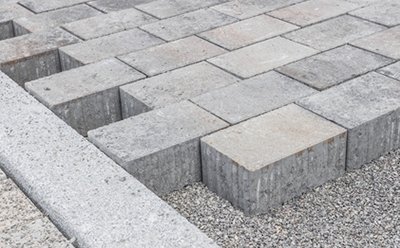Installing concrete pavers:
- Planning and layout – measure the area to be paved. Make sure there are no obstructions. Determine the number of square meters.
- Calculating the number of pavers needed – multiply the number of pavers per square meter with the number of square meters of your area. If a lot of cutting is required, add 10% to the total.
- Excavation – establish the height the pavers should reach and not exceed. Calculate the total depth of excavation needed by adding the thickness of the base, the sand bedding and the paver itself. This gives you the total depth needed to excavate. Dig out the indicated depth, level and compact the ground using a compacting machine.
- Geo-textile – to prevent plants and roots of plants to interfere with the pavement, if available, a geo-textile is placed between the soil/ filling material and the base material, i.e. the gravel.

- Base material – the base material should be gravel and the thickness of this layer depends on the use of the paved area. Compact thoroughly.
- Edge restraints – are necessary to keep the pavers in place. This could be a wall of a building or an existing structure. If there is nothing, curbstones have to be installed in concrete ( see diagram above).
- Sand bedding – the pavers should be laid in a bed of sand about 2.5 cm thick. Level carefully,
- Laying pavers – lay the pavers as close together as possible. Use a rubber hammer. Where necessary, cut them using a diamond blade.
- Sand joints – fill fine sand into the joints between the pavers using a broom. Make sure the joints are filled with sand completely.
 |  |
Maintenance of concrete pavers:
- Concrete pavers require very little maintenance. An occasional sweeping or hose rinsing will keep them clean enough. If weeds find their way through the surface, just remove them as soon as they appear..
- Should tree roots,or settling damage a section of the paved area it is easy to remove the affected pavers, fix the underlying problem, and put the driveway back together.
- For heavy oil or grease stains, use a pressure washer with an appropriate cleaning solution.
- Depending on weather exposure, you may need to replenish the sand in the paver joints every 2 or 3 years if it is washed out.
 Download Installation Guidelines
Download Installation Guidelines



